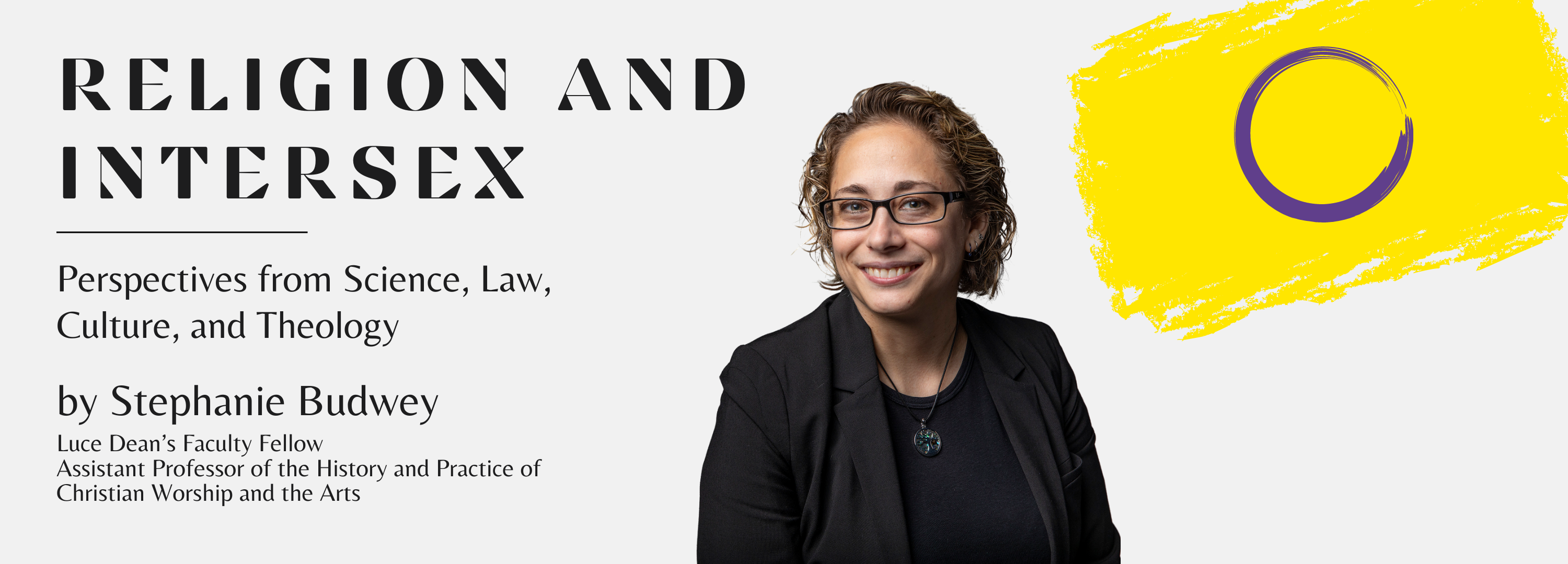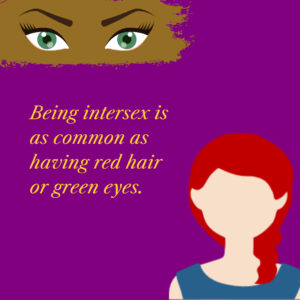Research on intersex experience highlights overlooked population in religious communities

“Like dogs, cats and tins of tuna, you are not the kind of thing which could be baptized validly.”
This is what intersex activist Sally Gross was told by another Christian, and an experience cited in the new book Religion and Intersex: Perspectives from Science, Law, Culture, and Theology, written by Stephanie Budwey, the Luce Dean’s Faculty Fellow Assistant Professor of the History and Practice of Christian Worship and the Arts and the director of the Religion in the Arts and Contemporary Culture program at Vanderbilt Divinity School.
Intersex is an umbrella term used for a variety of situations in which a person is born with reproductive or sexual anatomy that falls outside the strict male/female binary. What makes someone intersex or not can be informed by any combination of sex characteristics: chromosomes, hormone levels, internal genitalia, and external genitalia. Identifying as intersex is separate from identifying as non-binary, as some intersex people do identify as a male/man or female/woman and not necessarily as non-binary and vice versa. Additionally, not all intersex people want to be included in the LGBTQ+ community while some do.
Budwey, who identifies as endosex, a term which refers to someone whose sexual or reproductive anatomy fits within typical definitions of female and male, had moved to Germany in 2013 for her post-doctoral work in practical theology as the country was enacting a new law that would allow for a “third option” for gender that would help parents feel less pressured to have their children undergo unnecessary, and often high-risk, surgeries and medical interventions simply to register their children with the government.
I wanted to hear about intersex people’s experiences in church in order to figure out what could be improved to make them feel more welcome in their faith communities.
-Stephanie Budwey, the Luce Dean’s Faculty Fellow Assistant Professor of the History and Practice of Christian Worship and the Arts
“I was interested to learn more about the intersex experience from this legal perspective,” says Budwey, who is conversant in German. “And I became interested in considering how our notions of sex and gender in Christianity are so binary. I wanted to hear about intersex people’s experiences in church in order to figure out what could be improved to make them feel more welcome in their faith communities.” For her latest book, Budwey interviewed six intersex Christian people in Germany to understand how they imagine God to be and what their images of God are. “Given that the Bible states that all humans are made in the image of God, I was curious as to how that would affect intersex folks’ images of God, particularly if they had negative experiences in their faith communities.”
The book’s wide disciplinary breadth—spanning culture, law, science, and theology—came about through her interviews and realizing that these varied fields are very much intertwined and often reinforce a binary understanding of sex and gender. The last section of the book on theology and liturgy serves as a guide for those who are interested to learn how they can offer intersex people robust pastoral care or advocate for them, which would require the foundational understanding Budwey provides in her book about the issues they face culturally, medically and legally.
As common as red hair or green eyes
Being intersex is a naturally occurring variation in humans, more common than most people realize, and it is rarely a medical problem that necessitates solving by surgery or other medical interventions. Estimates suggest that 1% to 2% of the US population are intersex, which is as common as having red hair or green eyes.
Despite that, when infants are born, they often must be registered as male or female in order to exist in medical and legal systems. If an infant is born intersex, the infant’s parents are often pressured by their doctor and the larger medical establishment to allow for surgery that would help the infant be physiologically classified as male or female.
Nik M. Lampe, a postdoctoral scholar in the Department of Medicine, Health, and Society and the Vanderbilt University LGBTQ+ Policy Lab, who is intersex, shares, “As a healthy infant from an upper-working-class household in the rural Midwest, I was in the hospital for five days after I was born, supposedly for a tympanostomy (i.e., tubes in my ears). Instead of a tympanostomy, medical records show that clinicians performed an unnecessary genital ‘normalization’ surgery due to my intersex variations.”
Instead of a tympanostomy, medical records show that clinicians performed an unnecessary genital ‘normalization’ surgery due to my intersex variations.
-Nik M. Lampe, a postdoctoral scholar in the Department of Medicine, Health, and Society and the Vanderbilt University LGBTQ+ Policy Lab
Lampe says they did not learn about this medical history until they were 24 years old, and that they have experienced many reproductive and sexual health complications throughout their life as a result of this procedure that their parents neither explicitly consented to nor had any knowledge about.
“Many intersex people across the globe have faced similar forms of non-consensual medical trauma due to normative assumptions of sex as a fixed, female/male binary system,” Lampe says.
Perhaps one of the most high-profile and widely known intersex people in the world is Caster Semenya, a South African middle-distance runner who won gold medals in the 2012 and 2016 Summer Olympics for the 800-meter track event. Semenya has higher levels of testosterone than is typical for women.
Following her victory at the 2009 World Championships, World Athletics, the international governing body for the sport of athletics that includes track and field, forced her to undergo sex testing. Though it cleared her to return to competition in 2010, it introduced new rules in 2018 for middle-distance athletes with intersex variations who are legally female and have testes, XY chromosomes, and high levels of testosterone. Intersex athletes were told to lower their testosterone levels to those of “a healthy woman with ovaries” by taking the contraceptive pill, receiving a monthly injection, or undergoing surgery to remove their testes. World Athletics has said that “biology has to trump gender identity to ensure fairness,” while critics have raised concerns about the rules’ undertones of racism and imperialism.
As a global event at the highest level of sport, the Olympic Games have an outsized cultural impact on how society views sex and gender. But science has increasingly bled into this cultural event as doping and other illegal competition enhancements have forced the involvement of governing bodies that utilize medical testing to regulate athletes and competition against a binary sex/gender paradigm that is often approaching a violation of United Nations human rights protections for intersex people.
Gendergap, Genderstar, Gendercolon
While Budwey addresses the cultural issues surrounding intersex identity in sport, she emphasizes the importance of language in facilitating the recognition and acknowledgement of existence and relevance. Many intersex people say they felt like monsters because they were told they did not have the right to exist or that they were “other” or “not human.” One of Budwey’s interview partners said they felt like a “Frankenstein monster” because of the surgeries they were forced to endure. Another said they felt they were a monster because they felt isolated in their experience, that there were no others like them. It was not until they found language defining and explaining intersex that they were able to find support groups and “feel human again.”
All those subjects who have been denied by force can be re-inscribed into language.
-Steffen Kitty Hermann, Institute for Philosophy at the FernUniversität in Hagen
The book includes an example from the German language, as there have been recent developments to create gender-neutral language. In German, nouns for people are gendered, so a male student would be “der Student” and a female student would be “die Studentin.” Language innovations like the “gendergap” (Student_in), the “genderstar” (Student*in), and the “gendercolon” (Student:in), help indicate what Steffen Kitty Hermann terms “a space that our language does not allow.”

“It represents all those who are either violently excluded or who don’t want to be a part of the binary gender system.…all those subjects who have been denied by force can be re-inscribed into language,” wrote Hermann.
Morning and night, dawn and dusk
Language from the Bible, particularly Genesis 1:27, is often used to justify exclusion from society or “forced inclusion” in a sex/gender that is unrelatable to an intersex person’s lived experience. Budwey, admittedly not a Bible scholar, consulted with colleague Annalisa Azzoni, a senior lecturer in Hebrew Bible and the director of global education. Azzoni’s interpretation of Genesis 1:27 is one of including all humans in all their differences. Additionally, Budwey drew from queer theologian Justin Sabia-Tanis’ work which posits that, in the Creation story, though there is morning and night, God also created everything in between, like dawn and dusk. Similarly, though we have land and sea, God also created beaches and marshes. Analogies such as these, which add context to or alternative interpretation of Christian scripture, are often a relatable “jumping off point” for introducing people to the concept that sex and gender are a spectrum, that it is not “male or female” but rather “male to female,” as one of Budwey’s interview partners said.
Previous examples given of night and day, dawn and dusk are but one example from the non-human world, according to Reverend Dawn Bennett (MDiv ’18), the pastor of The Table and a pastor developer. The Table is an LGBTQIA+-centered faith collective where “everyone has a seat at our table and we affirm people of all races, ethnicities, cultures, abilities, ages, sexual orientations, gender identities, gender expressions, and relationship statuses.”
Creative and inclusive worship services are opportunities to discover more about who God is and how God is represented in our world.
–Reverend Dawn Bennett (MDiv ’18), pastor of The Table and pastor developer
“All of life is a spectrum. If we as created beings can so easily accept this variable of nature, it should not be a stretch to understand and accept that, as human beings formed in the very image and likeness of God, we too carry within our species this most wondrous spectrum,” says Bennett, who also points to the trinity – God in three persons – as definitive example of life being a spectrum.
“As a person with green eyes, I have never been harmed or mistreated because of my eyes,” Bennett adds. She feels it is incumbent upon pastors and Church institutions to create space for the full spectrum of intersex people to be included because their experiences are crucial to the vitality of the Church. “Creative and inclusive worship services are opportunities to discover more about who God is and how God is represented in our world,” she says.
An inspirational benchmark from the EU
Banning medically unnecessary surgeries that force children to anatomically match one or another binary sex/gender, which are usually performed without their consent, would be a significant step in preventing trauma among intersex people born in the US. For example, Malta passed the Gender Identity, Gender Expression and Sex Characteristics Act in 2015, which made it the first country in the world to prohibit medically unnecessary surgery on the genitals of intersex infants. The law also enables parents or guardians of intersex children to postpone entering their child’s gender on their birth certificate, thus avoiding decisions for rushed, serious and often-irreversible surgery.
“As an intersex woman of faith, I believe Dr. Budwey’s expertise on religion and intersex could not have arrived at a better time to provide important information where little exists,” says Marissa, a program coordinator for interACT: Advocates for Intersex Youth. “Budwey is one of the few religious scholars dedicated to this exceptional topic, and beautifully centers intersex people’s right to bodily integrity, autonomy and self-determination in a way that everyone should be keen to learn.”
Stigma and conflation
Budwey says that she was only able to find six interview partners that were willing to speak with her, which is a reminder that being intersex is still very difficult to talk about, says Budwey. “A lot of the people I spoke with wanted to remain anonymous because they had such traumatic experiences related to their identity, and there is still a lot of stigma around being intersex. The reality is that most people don’t even know what being intersex is because it’s rarely discussed and often misunderstood.”
“The reality is that most people don’t even know what being intersex is because it’s rarely discussed and often misunderstood.”
-Stephanie Budwey, director of the Religion in the Arts and Contemporary Culture program
“Intersex people have been silenced and erased from our society—physically, through these ‘corrective’ surgeries, and legally, due to the lack of protective laws that provide for their existence,” says Budwey. The more people are aware of intersex people and the more they understand that sex and gender is a spectrum rather than a binary, the more intersex people will have an inclusive experience in our society that is devoid of discrimination that includes human rights violations as well as physical and psychological trauma resulting from unnecessary medical interventions, Budwey explains.
To raise this awareness Budwey has organized a discussion panel for Intersex Awareness Day on Wednesday, October 26, from 7pm to 8:30pm CT (register here). The discussion will be moderated by Rev. Dawn Bennett (MDiv ‘18), Pastor Developer at The Table. Co-sponsored by the Carpenter Program in Religion, Gender, and Sexuality, the Religion in the Arts and Contemporary Culture program, the KC Potter Center for LGBTQI Life, and the Vanderbilt LGBTQ+ Policy Lab, the panelists include:
- Marissa – program coordinator at interACT: Advocates for Intersex Youth
- Stephanie Budwey – Luce Dean’s Faculty Fellow Assistant Professor of the History and Practice of Christian Worship and the Arts and director of the Religion in the Arts and Contemporary Culture program at Vanderbilt Divinity School
- Nik M. Lampe – postdoctoral scholar for the Department of Medicine, Health and Society and the Vanderbilt LGBTQ+ Policy Lab
For Intersex Day of Remembrance, a service will be held on Sunday, November 6 at 7pm at The Table. This service will be led by the Rev. Dawn Bennett, and include reflections by Marissa and Stephanie Budwey. It will also include newly composed hymns for this service that explicitly use the term “intersex” by Dan Damon. The service will be held in person and is also available to watch on The Table’s Facebook page.
